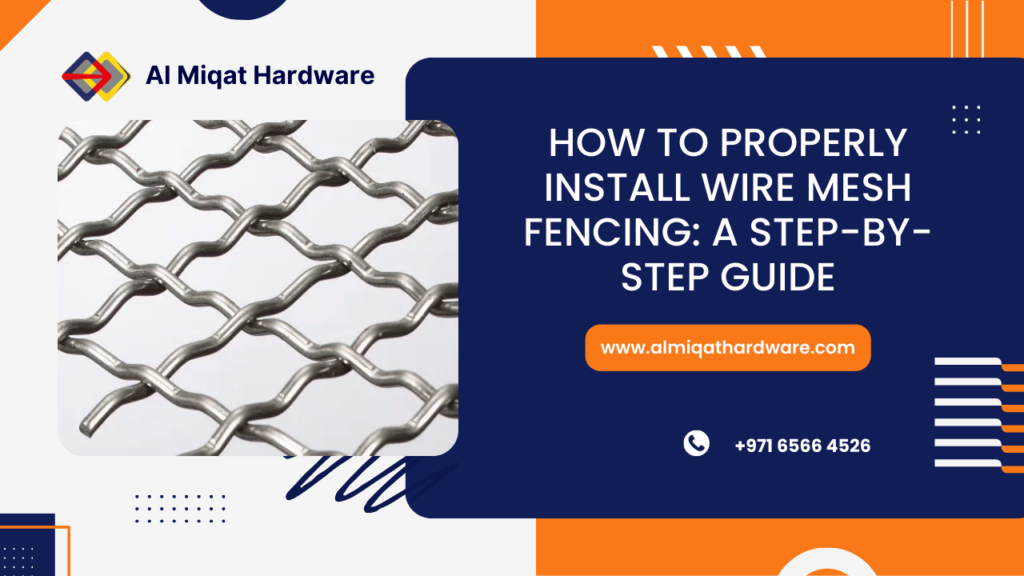Wire mesh fencing is a durable, cost-effective, and versatile solution widely used in construction, agriculture, security, and industrial applications. Proper installation is crucial to ensuring the fence’s longevity and effectiveness. This guide walks B2B buyers, construction professionals, and hardware tool purchasers through the process of installing wire mesh fencing correctly.
Planning and Preparation
Before installation begins, proper planning is essential to avoid common mistakes and ensure a secure, long-lasting fence.
Assessing the Site
- Conduct a thorough site survey to determine the fence line and identify obstacles such as trees, rocks, or underground utilities.
- Mark the boundaries clearly using stakes and string lines.
- Check local regulations or property boundaries to ensure compliance with fencing laws.
Selecting the Right Materials
Choosing the correct wire mesh type and fencing materials is crucial for durability and function.
- Types of wire mesh:
- Welded wire mesh – Offers strong and rigid fencing, ideal for high-security applications.
- Woven wire mesh – More flexible, suitable for enclosures and barriers.
- Mesh size and gauge:
- Smaller mesh sizes provide more security but can be more expensive.
- Thicker wire gauge enhances durability.
- Fence posts:
- Choose from metal or wooden posts based on longevity and aesthetics.
- Ensure the height of the posts matches the fencing needs.
Gathering Necessary Tools and Materials
- Measuring tape
- Level
- Post hole digger or auger
- Shovel
- Hammer or mallet
- Wire cutters
- Tensioning tools
- Protective gear (gloves, safety glasses)
- Concrete mix (if setting posts in concrete)
Installing Fence Posts
The fence posts provide the foundation for the wire mesh fencing, so correct installation is crucial.
Marking Post Locations
- Use a measuring tape to space posts evenly (typically 2.5 to 3 meters apart).
- Ensure the posts align with the string line for a straight fence.
Digging Post Holes
- Use a post hole digger or auger to dig holes at least one-third of the post height for stability.
- The depth and diameter of holes should accommodate the post size and soil type.
Setting Posts
- Place posts in the holes and use a level to ensure they are straight.
- For enhanced stability:
- Fill holes with concrete mix and allow time to cure.
- If using soil, compact it firmly around the base of each post.
- Let concrete set for at least 24 hours before proceeding with the next steps.
Installing Tension Wires
Tension wires add support to the wire mesh and maintain its rigidity.
Attaching Tension Wires
- Run tension wires along the top, bottom, and middle sections between posts.
- Secure them to end and corner posts using tensioners or strainers.
Tightening Tension Wires
- Use a wire strainer or turnbuckle to tighten the tension wires.
- Ensure the wires are taut to prevent sagging and ensure fence stability.
- Unrolling and Positioning the Wire Mesh
Unrolling the Mesh
- Lay the wire mesh flat along the fence line to avoid kinks or bends.
- Have a second person assist in handling large rolls for easier alignment.
Positioning the Mesh
- Stand the mesh upright against the fence posts.
- Start from one end and gradually work along the fence line.
Unrolling and Positioning the Wire Mesh
Unrolling the Mesh
- Lay the wire mesh flat along the fence line to avoid kinks or bends.
- Have a second person assist in handling large rolls for easier alignment.
Positioning the Mesh
- Stand the mesh upright against the fence posts.
- Start from one end and gradually work along the fence line.
Securing the Wire Mesh to Posts and Tension Wires
Attaching to End Posts
- Fasten the wire mesh to the starting post using staples, clips, or fencing ties.
- Ensure it is securely anchored before moving to the next step.
Tensioning the Mesh
- Use a fence stretcher or come-along tool to apply tension and eliminate slack.
- Keep the mesh aligned and level as you work along the fence line.
Securing to Line Posts and Tension Wires
- Attach the mesh to intermediate posts at regular intervals using:
- Metal clips
- U-nails (for wooden posts)
- Tie wires
Secure the mesh to the tension wires with fencing staples or ties.
Finishing Touches
Trimming Excess Mesh
- Use wire cutters to remove any excess mesh at the end post.
- Ensure the cut edges are smooth to prevent injuries.
Inspecting the Fence
- Walk along the entire fence line to check for loose connections or uneven sections.
- Ensure all posts are stable and mesh is properly tensioned.
Making Necessary Adjustments
- Tighten any loose wires or re-secure weak areas.
- Apply protective coatings if needed to enhance durability (especially for galvanized or stainless steel mesh).
Conclusion
By following this step-by-step guide, construction professionals and hardware buyers can ensure a secure and durable wire mesh fence installation. Proper planning, material selection, and installation techniques are key to achieving a long-lasting fencing solution. For high-quality wire mesh fencing materials, Al Miqat Hardware in UAE provides a wide range of reliable options to meet your project needs.
Ready to get started? Contact Al Miqat Hardware today for premium wire mesh solutions!


